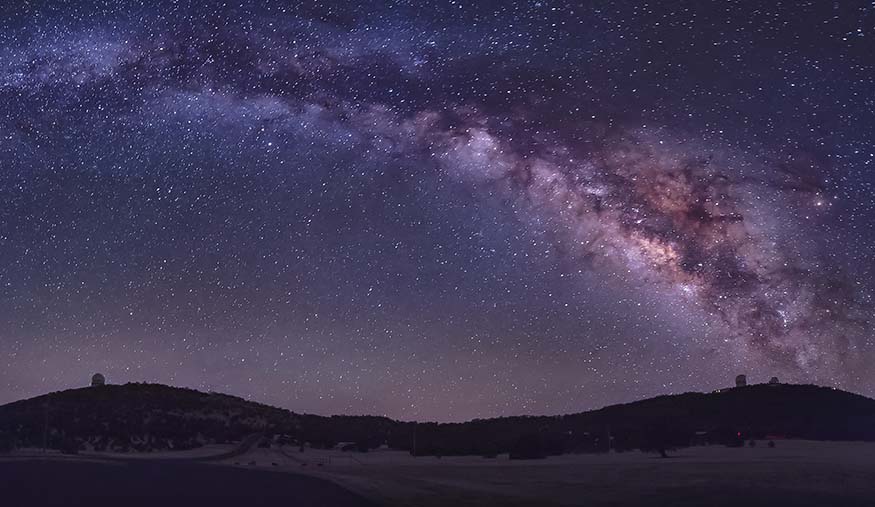
BEAUTY: 
BRAGGING RIGHTS: You saw our home galaxy
HOW EASY IS IT TO SEE? Dark skies required
BEST TIME TO SEE IT: February to September
TYPE: Galaxy
DISCOVERED: Known since antiquity
Some people say that scientific knowledge destroys beauty, that knowing that a rose is just a complex arrangement of carbon-based molecules somehow interferes with appreciating its beauty. But I disagree: appreciating beauty is a visceral feeling, wholly separate from the scientific pleasure of unraveling a puzzle.
So it is with the Milky Way. Once I visited the Grand Canyon at night and saw a brilliant sky, almost as flashy as a Las Vegas casino. And the dominant feature was a frozen river of silver light, arcing across the sky, and bounded by craggy edges. It’s a sight that has stayed with me ever since.
Hundreds of years ago, people must have looked at the Milky Way and felt the same thing. Yet today we know something they did not: that the river of light is our home galaxy, a spinning assemblage of 400 billion stars, many hosting planets of their own. Such knowledge only makes the sight more awesome.
Though powered by billions of suns, the Milky Way is so large and sparse that it appears as faint as a ghost to us. The light of the moon overwhelms it, and even a small amount of light pollution renders it completely invisible.
WHAT YOU MIGHT SEE THROUGH AMATEUR EQUIPMENT
Before cities and electric lights, it was possible to see the Milky Way from anywhere, but today you’ll see it only under the darkest skies. I’ve seen it faintly from the suburbs of San Francisco, but it paled next to my Grand Canyon memories. Choose a moonless night and travel out as far away from city lights as you can. Make sure you choose a spot where you can see the entire sky.
Once you’ve found a place, take in the whole view. Just standing beneath the Milky Way is enough to make you fall in love with the night sky. The unaided eye is best to appreciate just how vast it is. A pair of binoculars allows you to resolve the gossamer light into millions of faint stars.
Still, mysteries remain. We do not have a clear view of the galactic core, for example. Vast clouds of dust block all visible light. But by studying other frequencies of radiation—radio waves, infrared, and x-rays—we’ve been able to determine that a super-massive black hole lives in the heart of our galaxy. Scientists think this black hole is more than 4 million times heavier than our sun. Stars in its vicinity whip around at incredible speeds.
How did this black hole form? How fast is it growing? What’s it like to be close to it? We don’t know. Future astronomers, perhaps some of you reading this book, will have fun trying to figure that out.
The band of light. The Milky Way Galaxy is a flat disk about 100,000 light-years across; the solar system is located about halfway between the galaxy’s core and its edge. The band of the Milky Way that we can see is our edge-on view of this galaxy’s disk.
Nebulae and star clusters are often found near the band of the Milky Way, since that’s where most of the stars in the galaxy are. But galaxies (and many globular clusters) are found away from the band. The Milky Way obscures our view of distant galaxies, so we need to look away from the disk to see them.
Toward the edge. During winter in the Northern Hemisphere, the night side of Earth faces toward the edge of the galaxy (away from the core). Compared to the summer view, you may notice that the band of the Milky Way is a little thinner.
Toward the core. In summer, we face the center of the galaxy. Unfortunately, massive dust clouds block our view, so we can’t see the bright core of the galaxy—a sight that would surely be magnificent. Nevertheless, the wide and graceful arc of the Milky Way is splendid. You may notice that in parts the band of the Milky Way is split by darker areas. These are dark dust clouds, obscuring the stars beyond.
The teapot of Sagittarius. The spout of Sagittarius’s teapot points to the center of the galaxy. Though we cannot see the actual core, there are marvelous wonders in this region. Use binoculars to scan the area and you’ll see star clusters and nebulae just floating in a sea of stars. Many of these objects are included elsewhere in this book, but it’s great to see their surroundings as well.